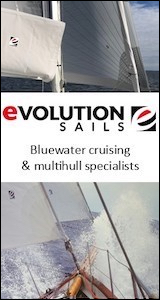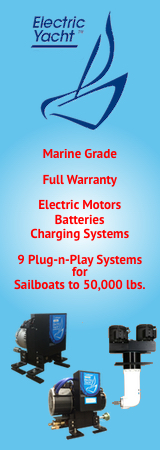Forum Replies Created
-
AuthorPosts
-
 PaulKParticipant
PaulKParticipantHave you looked at Marine Traffic?
It helps to have a rough idea of where the ship is headed. Bets are off if the ship’s AIS is not on.
In that case, you’ll need radar and/or someone on watch, looking. PaulKParticipant
PaulKParticipantA spray hood would not seem to be something you would buy off the shelf at Jeanneau, since the last Brin de Folies were built in 1980. It will have to be built in place. The simplest approach might be to attach (bolt) a wood base to the cabintop along the sides and forward end of the open hatch. Leave holes or small gaps so that any water that gets in can drain out. (It’s a boat. There will be water getting in.) The tops of the base pieces should be perhaps 1/4″ higher than the top of the hatch. The top of the forward piece will need to be curved to match the curve of the hatch.You may also need a curved wooden frame piece on the aft end to make sure the cover is supported clear of the hatch. You can then perhaps find a sheet of fiberglass or plastic that will bend to match the curve needed, and screw or bolt it down to the frame. Voilà: spray hood.
For winches have a look on EBay or Craigslist.November 24, 2022 at 12:38 am in reply to: Https://sailboatdata.com/sailboat/hunter-31?units=imperial #86056 PaulKParticipant
PaulKParticipantPeople usually pay a surveyor for an inspection after the seller accepts their offer on a boat. The best thing you can do is go with him (or her) for the survey. You can listen to their observations and learn a lot. Ask them questions and learn more.
 PaulKParticipant
PaulKParticipantThe bowsprit made me think “Cape George”. They make one that’s 31’ .
https://sailboatdata.com/sailboat/cape-george-31.
Hard to tell without a view of the rudder setup and spreaders. The Cape George 31 has a transom-hung rudder, two sets of spreaders and only has four portholes in the cabin trunk, so perhaps not.November 12, 2022 at 10:39 pm in reply to: 97 Hunter 430 what is the storage behind settee for #86021 PaulKParticipant
PaulKParticipantWe might use space like that for stowing “essential liquids” Bottles can be packed there so they are readily available, but aren’t likely to bounce around and break. It would also be easy to put flares there. They’ll stay dry and be, again, readily available.
 PaulKParticipant
PaulKParticipantYou can try shutting different seacocks to see which one stops the salt water flow. Or you can follow the water pipes or tubes back to where they exit the hull. A camera on a probe might be useful for that, since poking around in the bilge or behind furniture might be difficult.
 PaulKParticipant
PaulKParticipantThe picture does clarify things. Those 2×6’s are pesky. They’re probably helpful for centering if you’re retrieving on a ramp, but certainly in the way now. Are they bolted on so that they could be unmounted? Otherwise, slapping some paint on in the slings is better than nothing.
 PaulKParticipant
PaulKParticipantIf you could post a picture we might be able to understand the problem better. It is usually quite simple to lift the bow of a boat on a trailer up by using a car jack with a wooden chock and a cushion under the stem area. This should lift it enough above any forward trailer pads to get a brush of antifouling there, while the stern pads hold it steady. When that’s dry, the same technique will work with the stern.
 PaulKParticipant
PaulKParticipantDo you really have to lift it that far to slide a brush loaded with antifouling between the pads and the hull? Even the bottom of the keel would just need a 2″ space to get a brush in there. You could probably get that by lifting the bow first, lowering it back down, and then doing the stern. If the wood centering piece is in the way can you remove it and replace it afterwards?
 PaulKParticipant
PaulKParticipantThere are probably many. Shaft diameter, engine horsepower and boat displacement will affect the size and pitch of the propeller, which may impact which manufacturer best suits the boat.
August 9, 2022 at 5:06 pm in reply to: Malbec 18 question about feel on helm – neutral/lee/weather – in light air #85833 PaulKParticipant
PaulKParticipantIf you’ve tried adjusting mast rake already, adjusting the centerboard might help with balancing the helm more to your liking. On a reach we find that opening the slot – moving the jib leads forward and outboard – adds a good bit of speed with other boats.
 PaulKParticipant
PaulKParticipantMaking it happen! At least cedar is somewhat rot-resistant, and now you can go sailing! What are you going to do with all the money you saved? Drinking that much beer would be bad for you!
 PaulKParticipant
PaulKParticipantPlywood is OK as a replacement so long as you can keep the water out. Any leaks will wick through the ply very quickly, since the grain runs flat across the sheet, and ruin the whole thing. Same with a plain board. It will work, but is not the best solution. This is one reason why end-grain balsa is actually better as a core. If water gets into a section, the grain will wick it in… all of 3/4″. Each block of balsa tends to get walled off from the others by the resin, which also helps to keep moisture from spreading. It’s also lighter.
Materials for your repair should not cost a lot. You should save about $500 doing it yourself. PaulKParticipant
PaulKParticipantLooks like a typical CCA type from the early 70’s. Long overhangs, short waterline. Big genoa. Attached rudder on modified full keel. Heavy. Pretty, but not fast. New sails might help. Less expensive options would be to make sure the bottom is smooth and clean. We have our antifouled bottom cleaned by a diver every two weeks. If you have a two-bladed fixed prop make sure it gets lined up vertically in the aperture when you shut down the engine, or get a folding prop instead. Offload as much cruising gear as possible – especially from the ends of the boat. This includes cushions. Move the anchor and chain to midships if you can. (Lash the anchor to the table leg.) Are the water tanks full? Fuel? Why? Is there a main traveler that goes across the whole cockpit? Using the traveler to keep the main from getting backwinded by the jib might be good. Make sure it has an easily adjustable car. Can you adjust the backstay? Tightening it up to get the forestay tighter might help with upwind legs. Release it going downwind. Practice tacks and maneuvers with the crew. One bad tack can hurt race results more than some of these ideas will improve them.
 PaulKParticipant
PaulKParticipantWhy change things? She does not appear to be overcanvassed. Adding weight will slow her down. Messing with the keel may give her quirks under sail that it might be better to avoid. It would also make selling the boat more difficult. If you want to take her out, take her out. The best boat to go sailing in is the one you have.
-
AuthorPosts




